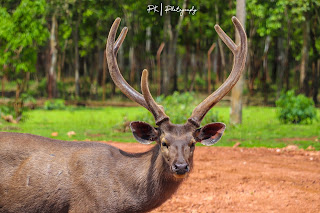Tyavarekoppa Lion and Tiger Reserve Shimoga
Lion safari shivamogga
 |
| Indian Tiger |
Bengal tiger
The Bengal tiger (Panthera tigris tigris) is the most numerous tiger subspecies in Asia, and was estimated at fewer than 2,500 individuals by 2011. Since 2008, it is listed as Endangered on the IUCN Red List and is threatened by poaching, loss and fragmentation of habitat. None of the Tiger Conservation Landscapes within its range is considered large enough to support an effective population of more than 250 adult individuals.
The tiger arrived in the Indian subcontinent about 12,000 years ago. India's tiger population was estimated at 1,706–1,909 individuals in 2010. By 2014, the population had reputedly increased to an estimated 2,226 individuals. Around 440 tigers are estimated in Bangladesh, 163–253 tigers in Nepal and 103 tigers in Bhutan.
The Bengal tiger ranks among the biggest wild cats alive today.It is therefore considered to belong to the world's charismatic megafauna. It is the national animal of both India and Bangladesh
Asiatic lion
 |
| Asiatic Lion |
The Asiatic lion (Panthera leo leo) is a lion population in Gujarat, India, which is listed as Endangered on the IUCN Red List because of its small population size. Since 2010, the lion population in and around Gir Forest National Park has steadily increased.[4] In May 2015, the 14th Asiatic Lion Census was conducted over an area of about 20,000 km2 (7,700 sq mi); the lion population was estimated at 523 individuals, comprising 109 adult males, 201 adult females and 213 cubs. In August 2017, the Asiatic Lion Census revealed 650 wild individuals.
The Asiatic lion was first described by the Austrian zoologist Johann N. Meyer in 1826 under the trinomen Felis leo persicus.Its historical range included eastern Turkey, Iran, Mesopotamia, and from east of the Indus River to Bengal and Narmada River in Central India.
The lion is one of five pantherine cats inhabiting India, along with the Bengal tiger, Indian leopard, snow leopard and clouded leopard. It has also been called Indian lion and Persian lion
 |
| Asiatic Lion |
Sambar deer
 |
| Sambar deer |
The sambar (Rusa unicolor) is a large deer native to the Indian subcontinent, southern China, and Southeast Asia that is listed as Vulnerable on the IUCN Red List since 2008. Populations have declined substantially due to severe hunting, insurgency, and industrial exploitation of habitat.The name "sambar" is also sometimes used to refer to the Philippine deer, called the "Philippine sambar" and the Javan rusa, called the "Sunda sambar"the large, rugged antlers are typically rusine, the brow tines being simple and the beams forked at the tip, so they have only three tines. The antlers are typically up to 110 cm (43 in) long in fully adult individuals. As with most deer, only the males have antlers.
The shaggy coat can be from yellowish brown to dark grey in colour, and while it is usually uniform in colour, some subspecies have chestnut marks on the rump and underparts. Sambar also have a small but dense mane, which tends to be more prominent in males. The tail is relatively long for deer, and is generally black above with a whitish underside.
Adult males and pregnant or lactating females possess an unusual hairless, blood-red spot located about halfway down the underside of their throats. This sometimes oozes a white liquid, and is apparently glandular in nature.
Striped Hyena
 |
| Striped Hyena |
The striped hyena (Hyaena hyaena) is a species of hyena native to North and East Africa, the Middle East, the Caucasus, Central Asia and the Indian subcontinent. It is listed by the IUCN as near-threatened, as the global population is estimated to be under 10,000 mature individuals which continues to experience deliberate and incidental persecution along with a decrease in its prey base such that it may come close to meeting a continuing decline of 10% over the next three generations.
It is the smallest of the true hyenas and retains many primitive viverrid characteristics lost in larger species, having a smaller and less specialised skull. Though primarily a scavenger, large specimens have been known to kill their own prey, and attacks on humans have occurred on rare instances. The striped hyena is a monogamous animal, with both males and females assisting one another in raising their cubs. A nocturnal animal, the striped hyena typically only emerges in complete darkness, and is quick to return to its lair before sunrise. Although it has a habit of feigning death when attacked, it has been known to stand its ground against larger predators in disputes over food.
The striped hyena features prominently in Middle Eastern and Asian folklore. In some areas, its body parts are considered magical, and are used as charms or talismans. It is mentioned in the Hebrew Bible, where it is referred to as tzebua or zevoa, though the species is absent in some Bible translations into English. Ancient Greeks knew it as γλάνος (glanos) and ύαινα (iena-hyena) and were familiar with it from the Aegean coast of Asia Minor.
The Indian wolf
 |
| Indian Wolf |
The Indian wolf (Canis lupus pallipes) is a subspecies of grey wolf that ranges from Southwest Asia to the Indian Subcontinent. It is intermediate in size between the Tibetan and Arabian wolf, and lacks the former's luxuriant winter coat due to it living in warmer conditions.[2] Two closely related haplotypes within this subspecies have been found basal to all other extant Canis lupus haplotypes apart from the older-lineage Himalayan wolf, and have been proposed as a separate species,
Some other birds and anmials at lion safari shivamogga
Tyavarekoppa Lion and Tiger Reserve Shimoga








